30. The Testimony of Former Private Ryu Jin-sung
Precursor to the Mỹ Lai Massacre: 1968 Phong Nhị, Phong Nhất_30: The Testimony of Former Private Ryu Jin-sung
Ryu Jin-sung, whom I met in June of 2018. He was both a victim (as he was taken to the hospital twice) and a member of the assailant group during the course of the war. Photograph by Humank
Click to read in Korean(야수가 야수에게)
Throughout the 18 years between 2000 to 2017, the only veterans to share their testimonies regarding the Phong Nhị and Phong Nhất incident were officers and noncommissioned officers. These people include Kim Seok-hyun, who served as commander of the 1st Battalion of the 2nd Brigade (Blue Dragon Unit), Choi Young-un, former commander of the 1st platoon, Lee Sang-woo, former commander of the 2nd platoon, Kim Ki-dong, former commander of the 3rd platoon, and Sung Baek-woo, Chief Inspector of the Military Police Unit of the 2nd Brigade. It was not until 2018 that I was able to get a testimony from a former private. It was from Ryu Jin-sung, who entered the town of Phong Nhị as a private of the 2nd platoon.
Among the officers who testified regarding the Phong Nhị and Phong Nhất incident of February 12, 1968, nobody denied the fact that a civilian massacre took place. However, testimonies were wide-ranging. Both Kim Seok-hyun, a lieutenant general with whom I spoke on the phone, and Kim Ki-dong, the commander of the 3rd platoon whose home I visited, acknowledged that the accident took place, but denied knowing exactly what the South Korean military did wrong. Second platoon leader Lee Sang-woo admitted the mistakes of the 1st squadron, albeit in a passive manner. Choi Young-un, the 1st platoon commander, said the soldiers of the 1st squadron were clearly responsible, estimating specifically that the civilian massacre occurred from among the 3rd platoon. The testimony of Ryu Jin-sung, a former private in the 2nd platoon, was most similar to that of Choi Young-un, the 1st platoon commander.
Ryu testified for the first time about what he experienced in Phong Nhị through a video recording (19 minutes) at the Civil Peace Court (Civil Peace Act to investigate the massacre of civilians by Korean soldiers during the Vietnam War) held at the Mapo Cultural Base in Seoul on April 21, 2018. However, at the time, he did not reveal his real name, and his face had been blurred out in the video. He fully reveals his face and name herein for the first time, sharing his recollection of the Phong Nhị and Phong Nhất incident, as well as his personal experiences on the battlefield. Former Private Ryu Jin-sung survived the delicate line between life and death on the battlefield and returned as a witness to the massacre of civilians.
Here are two photographs:
One belongs to the U.S. military. There must have been an attack by the enemy. There are many wounded people lying on the tank being transported with bandages on their arms, stomachs and faces. Blood is trickling down their legs. It was supposedly taken immediately after a skirmish in the Hue area. The fierce tension of the battlefield and the silent screaming of the wounded are nearly tangible in photograph, which was published in the American magazine, Life.
The other photograph belongs to the South Korean military. A soldier of the White Horse Division, the 9th Infantry Division, is said to be rescuing a child in critical condition through the smoke of an incendiary bomb in a village in Cam Ranh to a safe place. The soldier looks righteous, brave and competent. It's a perfect encapsulation. The photograph was taken in 1968, by a reporter for the JoongAng Ilbo, Korea.
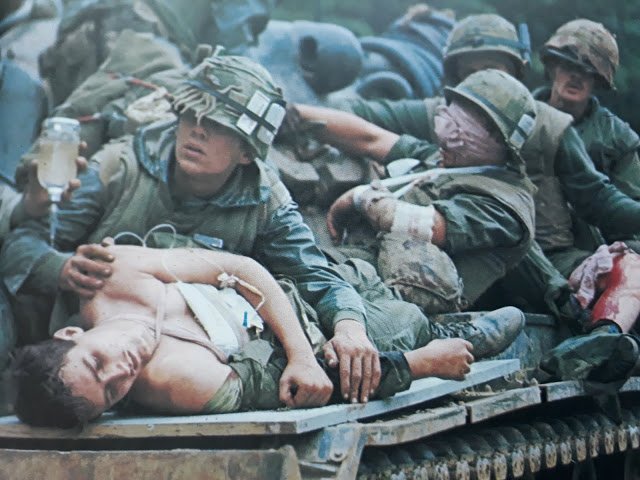
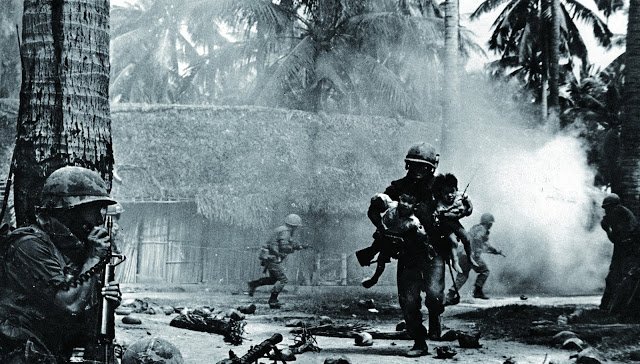
Photos of soldiers in the U.S. magazine Life (above) and Korean newspapers, respectively, during the Vietnam War. Few South Korean media coverage photos showed the anxiety and pain of the war veterans. <Life> <1969 Annual Press Photographs>
The contrast between the two pictures is symbolic. During the Vietnam War, few wounded soldiers appeared in South Korean media coverage photos. The South Korean military was portrayed as the winner of a valiant battle (directing combat scenes) or leisurely looking down on the corpses of the Viet Cong. It was different from the U.S. media's press photos that constantly evoked the anxiety and fear of soldiers on the border of life and death. South Korean soldiers only came out with carefree or reminiscent expressions. They were more of public relations photos than they were press photos. Under the control system under the dictatorship of Park Chung-hee, whose deployment of soldiers to the Vietnam War was part of a national revival program, it would have been an act of creating social unrest to reveal the true nightmares and tragedies of soldiers mobilized for other wars.
Ryu Jin-sung, 73 returned home on a bed after participating in the Vietnam War. He was classified as a serious patient and underwent surgery at the Da Nang U.S. Army Hospital and transferred from the Clark U.S. Air Force Base in the Philippines to an airfield in Daegu, where he came to Jinhae. It was in the spring of 1969. He was one of a total of 10,962 people that made up the Korean casualty statistics during the deployment period (1965-1973).
I had two interviews with Ryu Jin-sung near his home in Yangcheon-gu, Seoul, on June 16, 2018 and on July 7, 2018, and also had a phone conversation with him on February 24, 2019. He was dispatched to Vietnam in October 1967 as part of the 2nd Brigade of the Marine Corps, and was of the 1st Battalion 2nd Company (as a private in the second platoon) that entered Phong Nhị and Phong Nhất on February 12, 1968. The first public disclosure of the experience was at the Civil Peace Court (Civil Peace Act to investigate the murder of civilians by the Korean military during the Vietnam War) held from April 21-22, 2018 at Seoul's Mapo Cultural Base. However, there was a limit to the 19-minute video recording statement in which his face was blurred out, and he also didn’t disclose his identity. When I met him in person, we talked about a wider range of topics, including his battle wounds. On the battlefields, Ryu was both a victim and an assailant.
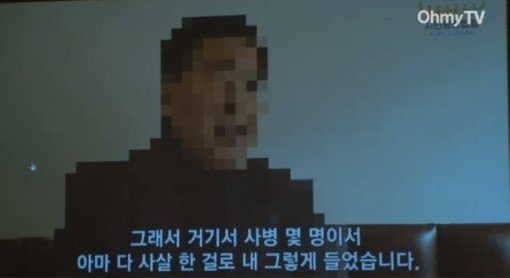
Ryu Jin-sung, testifying on the Phong Nhị and Phong Nhất Incident through a video recording of the Civil Peace Court on April 21, 2018. He did not reveal his real name and had his face covered through mosaic effect.
He was twice on the verge of death. The first crisis was in early June, 1968, when he and the 2nd platoon members were conducting reconnaissance patrol in the jungle in a double file. A fellow soldier, who was 10 meters way, touched the tripwire of a booby trap. Ryu was also hit by shrapnel and his right cheek was torn. He was taken to the U.S. Army hospital in Da Nang, but the wound was not too deep, so it ended with a simple suturing operation. A few days after being evacuated, he heard that a company commander also stepped on a booby trap and was brought to Da Nang. It was Lieutenant Eun Myung-soo, the captain of the 1st company.
“All of us in the company knew that our former commander, Kim Seok-hyun, was forced to return home early due to an unsavory incident. Commander Kim Seok-hyun was from North Korea, but his complexion was dark and his demeanor a bit cruel. In fact, he didn’t receive a positive assessment from the company members because he would mistreat them. In contrast, company commander Eun Myung-soo was a handsome gentleman, making him admittedly a bit vain. He made volleyball courts in the base, and was supposedly a former goalkeeper for the Naval Academy's soccer team. It was said that he went into a civilian home and kicked something woven with bamboo for no apparent reason, and the thing exploded.”
Lieutenant Eun Myung-soo assumed the post of company commander on March 7, 1968. It happened right after former company commander Kim Seok-hyun abruptly returned home in early March. The company members speculated that Kim's sudden return was due to the February 12th incident. The first company entered and left the villages after being attacked, whereby dozens of residents were found dead, stirring unpleasant rumors. However, on June 4, his successor, Lieutenant Eun, was severely injured by a booby trap explosion and died while being transported. Lieutenant Eun became one of the 5,009 Koreans who lost their lives during the dispatch period.
Ryu Jin-sung was treated in Da Nang and within two weeks assigned to a security company instead of the first company to which he had been originally assigned. The 2nd platoon of the security company of the 1st Battalion. He could not remember the name of the new unit's garrison. He only said they operated in ambush in a delta where the river and the sea meet. Based on the description, I assume it was near Hoi An, which connects to the Thu Bồn river. He eventually underwent his second crisis here around December of 1968.
"It was time to do a mission shift at the encampment where we were on all-around security. I was going down from the encampment and the successors were coming up when I heard the sound of a grenade's detonator. At that moment I grabbed a successor who was standing in the very front and pulled him towards me. Thanks to me, he was fine. Two other kids and I got hurt." He suspected that somebody crawled to the bottom of the encampment and threw a hand grenade.
"When it detonated, I felt my body lifting off the ground, and the smell of gunpowder came swarming into my nostrils. I reflexly tried to move my hand after falling to the ground, but I didn't have my left hand. So I looked and found that my severed left hand had flown behind my neck and landed on my right side. And I felt extreme pain in my left leg as if it had been torn into pieces. From 100 meters ahead, they all jumped out shooting their flare guns and carried the wounded soldiers on stretchers. The privates were even crying. That's how we all went to Da Nang on a helicopter."
It wasn't just my left arm and leg. I suffered a penetrating wound in the abdomen from where my guts spilled out. The left leg might have had to be amputated as well. U.S. Army doctors at the Da Nang Hospital asked him to try to move his toes on his bedside. His left foot seemed to have swollen to two or three times its original size. No matter how hard he tried, his toes wouldn't move. He begged the military doctor not to amputate his leg. An interpreter dressed in military uniform who was an Australian national conveyed the doctor's message. "If we perform surgery now, they are going to cut below your knee. But if we wait a few more days, and your wound rots, they would have to cut below your thigh." By that point, I decided that it was better to just die. I told them that no matter what, no leg amputation is allowed. I went into the surgery room for an open operation on my stomach. It was chilly in there because the anesthesia wasn't working fast enough for me. My teeth were chattering. I fell into a deep sleep worrying about my leg.
"It took a week for me to finally open my eyes. It was dark with only a few lights. I was in an intensive care unit. But I couldn't see my leg. They put a sheet over it, but I couldn't move my body. My left arm had to be stretched and attached, so they transfixed it with metal and a sandbag. There was an IV poked into my right hand for the delivery of antibiotics so I couldn't move it either. I wanted to take a look at my left foot, to make sure it was still there, but I couldn't even dare to look at it because I was so nervous, but I couldn't avoid it altogether either. Somehow, the sheet moved over slightly, and I could see my big toe. I've never been happier than in that moment.
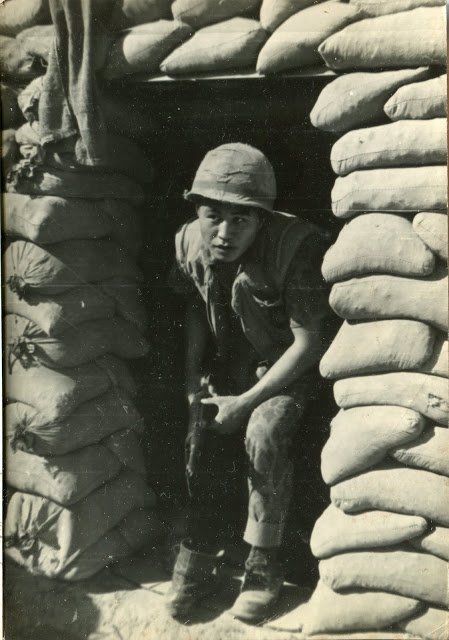
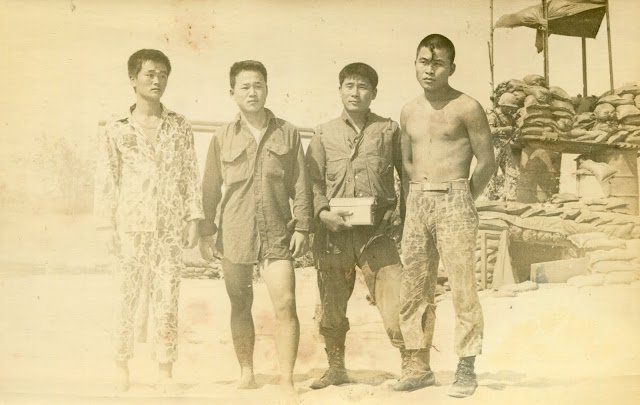
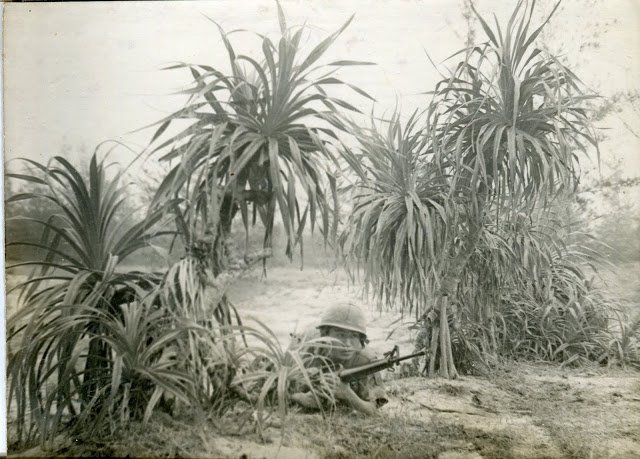
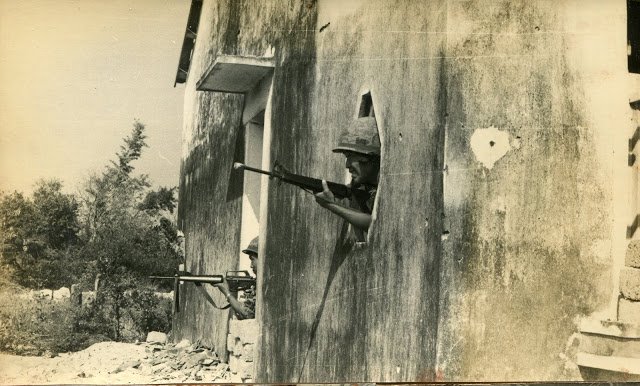
Photographs taken by Ryu Jin-sung in Vietnam in 1968. He is the one on the far right in the group photograph. Photographs provided by Ryu Jin-sung
The day I caught a glimpse of my toe was the best day of my life. The military doctors continued dressing my fractured and swollen left leg every day. I was still on my sickbed when they transferred me over to Quy Nhơn Hospital and the Clark U.S. Air Force Base, before sending me back to Korea, where I received a skin transplant at the Naval Medical Group in Jinhae. I was declared a grade 2 injury.”
In October of 1969, he was discharged on crutches and returned to his hometown of Jeonju. In order to make ends meet, he began working at a dredging workshop. At the time, the government was in the process of refurbishing the stream with the aid from the U.S. He pulled a hand cart loaded with soil with one hand, hopping on one leg. If he worked three days, he would receive two sacks of flour. Eventually, in the spring of 1970, he began working as the head of the guidance department at the North Jeolla branch of the Korea Association for Disabled Veterans. His responsibility was to discipline the feisty members of the Association. It was a position that, though not always, required physical and psychological stamina, not to mention being thick-skinned.
Having stamina and being thick-skinned were his forte. Ever since he was young, he was used to physical battles too. Because he wasn't afraid to fight, he was assigned as an advance guard of the platoon when he was a private first class. But bravery is never synonymous with cruelty or ruthlessness. He cannot forget the shock he felt during his initial operation in Hoi An in February 12, 1968.
"I went into the yard of a house in the village which I later found out was Phong Nhị. I was with the commander of the second platoon and another senior officer. The second platoon commander, Lee Sang-woo, was a man of great physical beauty. From the bomb shelter of the house, an old man, the waist of his trousers drooping, came out entreating. The lieutenant was taken aback and muttered in Vietnamese to just go. When the old man kept saying things he couldn't understand, the corporal next to him said, "For fuck’s sake, can't you even handle this?" He proceeded to set his M16 on auto and shot the old man, whose body then danced like a monkey from all the bullets. I was certain that corporal was hell-bound-- that there’s no way in heaven that he’d go unpunished, but he returned home unharmed."
The official death toll from the Phong Nhị and Phong Nhất incident is 74. Most of the victims were women, children, and the elderly. Ryu Jin-sung said in his video testimony to the civil peace court on April 21 last year that the mass shooting must have taken place among the 1st platoon. However, the late Choi Young-un (1942-2018), a former commander of the 1st platoon, mentioned that it happened in the rear, where the 3rd platoon would have been. Ryu corrected himself, saying that if Choi Young-un said it was the 3rd platoon, it must be correct. “I also heard that the shooting took place in the far end. They supposedly gathered all the corpses in the rice paddies and asked the company leader what they should do, and he made a gesture of slashing his throat with his hand.”
At the scene of Phong Nhị and Phong Nhất, a couple babies survived in a dramatic way. From what we know so far, there were three infant survivors aged between 0 and 3. According to Ryu Jin-sung's testimony, however, there was also an unlucky baby. “They shot a nursing mother, and the baby flew out of her arms from the shock of the gunshot. I heard this from the members of the platoon that was responsible. Supposedly, they bragged about what they had done."
Ryu said he was ordered to kill all living creatures, whether they be chickens or pigs, when they enter operational zones designated as free shooting zone. It came as direct orders from the brigade commander. Ryu told me about how he had followed the order faithfully not long after the Phong Nhị incident. "We were waiting in ambush in the operational area of the Dien Banh prefecture, when a woman walked by the open field, a few hundred meters ahead. We shouted, “Lai Lai,” motioning for her to come, but when she ran away, the platoon members fired intensively. I also pulled the trigger, too. It was a human hunt. She tried to get up and continue running, even after she was shot, so we even pulled out a 60-millimeter mortar. She eventually fell to the ground and was immobile. But as it turned out, she was the wife of a South Vietnamese officer. There was an order for a proper burial at night. We formed a special team and went to the scene to bury her corpse using shovels."
The village of Phong Nhị was not a free-shooting zone that could be swept away, but rather a fire control zone, as there lived a lot of South Vietnamese families in Phong Nhị. After the incident, residents rose up and took action. The South Vietnamese government couldn't turn a blind eye either. Nearby U.S. soldiers, who witnessed the South Korean troops entering the village, performed rescue operations at the scene and even took photographs. U.S. military authorities also investigated the incident, though the related documents were not released until 2000.
"I remember the morning of February 13, 1968. We were on reconnaissance patrol at the number one national highway, and the residents of Phong Nhị, who were laying out the corpses of the victims, were glaring at us with anger in their eyes. I got goosebumps. I wondered how we would get past them later, given that I was at the forefront of the company. When the Korean troops drew near, they yelled and pointed their fingers at us. I forced on a sinister expression and pushed through the crowd. It felt like someone would stab me in the back with a knife. I didn't even know why these people were behaving the way they were until later when I learned about what happened the day before."
Ryu spent more than 40 years in the realm of the Korea Association for Disabled Veterans. He served as the head of the Jeonbuk branch's guidance department twice and once as a central delegate. He is critical of the present Disabled Veterans Organization. He believes that it is time for Kim Duk-nam, who has been chairman for the third generation since 2012, to step down. Ryu is the chairman of a committee that he formed with like-minded individuals to purge the deep-rooted evils of the Disabled Veterans Organization. As the chairman of the committee, he went on a one-man protest in front of the Blue House and happened to run into a group of young people who also came out for a one-man demonstration demanding an official apology to Vietnam. This was on November 2, 2017. This is how Ryu got involved as an anonymous witness at the Civil Peace Court.
On April 22 of last year, Kim Young-ran, former Supreme Court justice who was a judge in the civil peace court ruled that the Republic of Korea pay compensation to the plaintiffs, the victims of the Phong Nhị and Phong Nhất case, according to the compensation criteria set by the state compensation law, and officially recognize and restore the dignity and honor of the plaintiffs. Though it is, in essence, a mock court, it is an important reference as there is a high possibility of actual state compensation suits going forward in the future. Outside the court, 70 Vietnam War veterans in their 70s roamed about. They made threatening phone calls, and insinuated that they would riot at court. They even created a collection of documents entitled, "The Truths behind the slandering of the Korean Army in Vietnam," claiming that claims of civilian massacres are outrageous defamation of the nation's armed forces and national pride, and distortion of history, which will mislead the people.
Ryu Jin-sung acknowledged, “Soldiers who were part of the 3rd platoon at the time must come out and speak up. The one that fired the gun should remember what he did, though who knows? Maybe if I had been in the 3rd platoon, I would have done the same thing in that situation." But before the perpetrator of the 3rd platoon pleads guilty, the 3rd platoon leader should come out. Kim Ki-dong, the former commander of the 3rd platoon, did not appear at the meeting place in October 2013 with an interview scheduled with me. Actually, even before that, the commander of the first company should come forward to acknowledge responsibility. Kim Seok-hyun, the former commander of the first company, completely denied knowing anything, during a telephone interview in April of 2000. He even denied the fact that he had been returned home earlier than was scheduled. As of current, I cannot reach him. Perhaps before any former leader, the state should step up to the plate. The state should reveal the 1969 records of the Central Intelligence Agency on the investigation of the Phong Nhị and Phong Nhất incident, which includes information on platoon leader, Commander Kim Seok-hyun, and noncommissioned officers.
To Ryu, the Vietnam War is one facet of his unfortunate life. He was beaten, and he also clearly witnessed others being beaten. "There's never a victor in war. Soldiers are not human during wartime. They’re just beasts. And war is a mere playground for these beasts." These beasts easily became unhappy. One small mistake could leave them dead or their entire bodies maimed. The state that had turned them into beasts constantly tried to hide the looming shadow of death from them, and only the scenes wherein they were gallantly “playing” war were displayed in the media. It was an undeniable fact that soldiers were killed or injured every day. The same was true of massacres. Such were things that could not be hidden with effort. Yet they still try to hide it. It’s as pathetic as trying to deceive oneself. Again, I take a look at the two contrasting photographs. And for some reason, I feel a greater degree of sympathy for the South Korean soldier who is courageously rescuing a child than for the U.S. soldier with his entire face bandaged.
- Written by humank (Journalist; Seoul, Korea)
- Translated and revised as necessary by April Kim (Tokyo, Japan)
The numbers in parentheses indicate the respective ages of the people at the time in 1968.
Read the last article
Congratulations @humank! You have completed the following achievement on the Steem blockchain and have been rewarded with new badge(s) :
You can view your badges on your Steem Board and compare to others on the Steem Ranking
If you no longer want to receive notifications, reply to this comment with the word
STOPTo support your work, I also upvoted your post!
Vote for @Steemitboard as a witness to get one more award and increased upvotes!